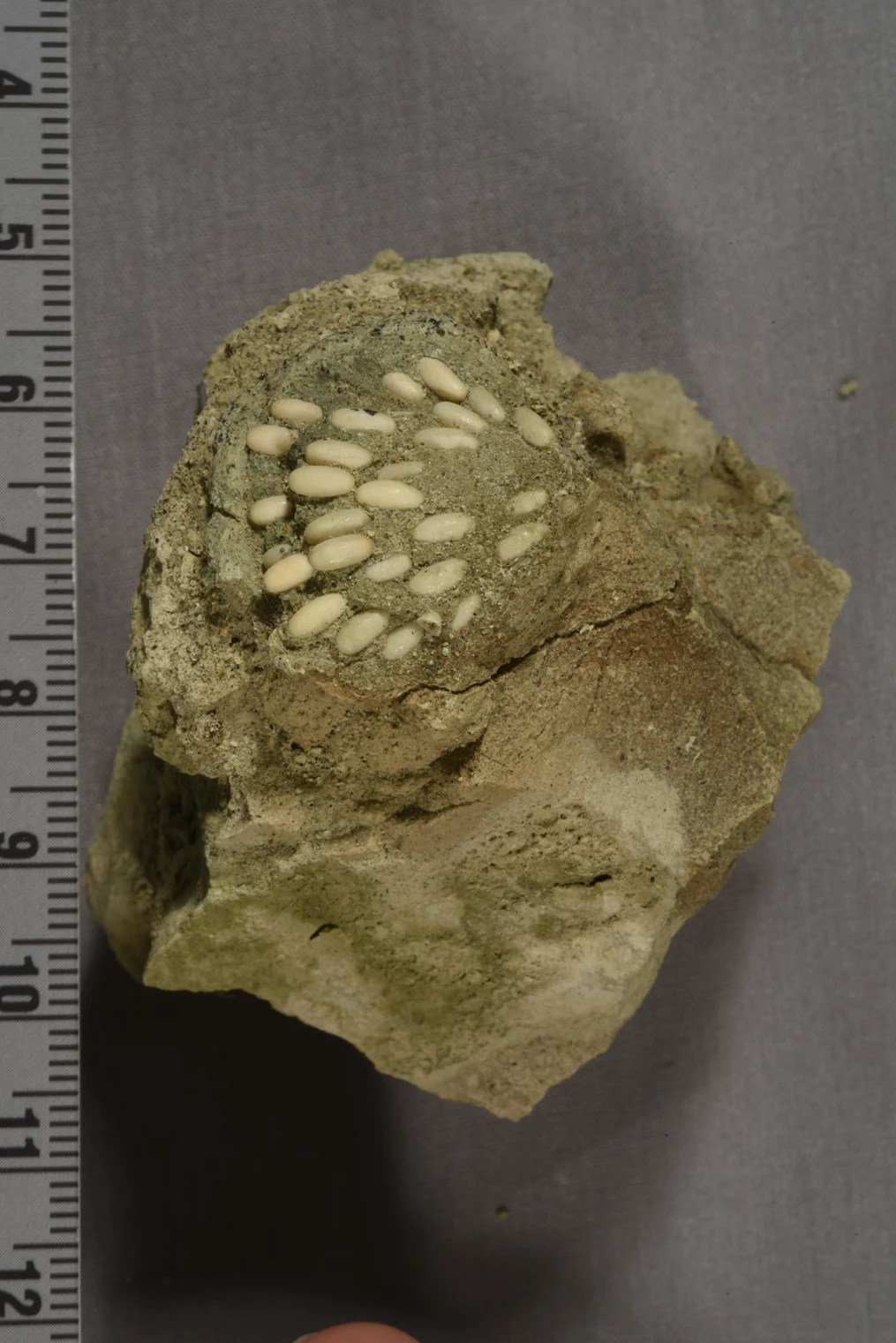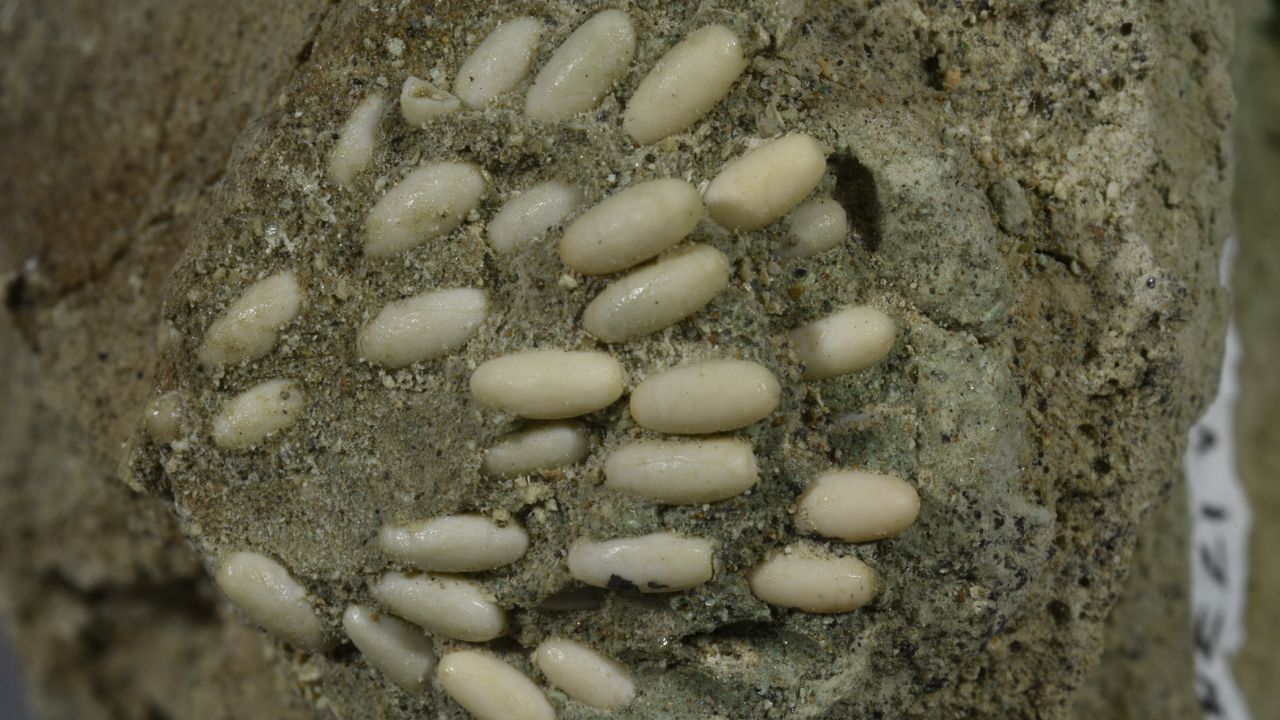(CNN) — In an ancient temperate forest in what is now Oregon, an insect burrowed deep into a sandbar near a stream. There, in a damp burrow, she laid dozens of elongated eggs, about 50 in total. Despite their meticulous work in building this underground shelter, no eggs ever hatched. Instead, the eggs, encased like pods, were fossilized into a mineralized stone block.
Now, 29 million years later, these discoveries are a record of insect reproduction that may be unlike anything paleontologists have seen so far.
A recent CT scan of the eggshell not only revealed that it was millions of years old, but also showed that it was likely the work of a grasshopper. The eggs and general structure of the nest are similar to the eggs and capsules of modern locust species. This new documentation provides a clearer picture of that ancient ecosystem, confirming that grasshoppers were present and thriving there, and that some species of grasshoppers buried their eggs underground.
Insect eggs are extremely rare in the fossil record, and intact egg pods are even rarer. The researchers stated that this may be the only known fossilized grasshopper egg capsule, and provides insight into its reproduction dating back to the Oligocene era (between 33.9 and 23 million years ago). Parks Management Forum.
“This work is exciting because such exceptional preservation provides unique insight into one of the least understood insect life stages, especially in the geological past,” Jaemin Lee, the study's lead author, told CNN in an email. Student at UC Berkeley.
Fossilization is intact
What makes this fossil even more remarkable is that it was found in a habitat that is not normally conducive to fossilization, said Dr. Nick Famoso, study co-author, paleontology program director and curator at Monument National John Day Fossil Beds. The site, located in Mitchell, Oregon, is managed by the National Park Service.
Microfossils like this specimen are usually preserved in lake sediments along with plant material. These places are usually oxygen-free, or low-oxygen, and relatively static, Famoso explains. There, fossils can form quietly, untouched by currents or bacteria. But millions of years ago, a river or stream passed through this place. However, Famoso explained that the conditions surrounding this egg capsule were suitable for it to remain buried and fossilize intact in near-perfect conditions, despite the dynamic environment of flowing water nearby.
The paleontologist said in an email that the eggs of this fossil are distinguished by their preservation “both individually and collectively.” Dr. Ricardo Pérez de la FuenteDeputy Head of Research at the Natural History Museum, University of Oxford, UK.
“They are the first orthoptera (grasshoppers and the like) identified in the fossil record, which is noteworthy,” says Pérez de la Fuente, who was not involved in the research.
“The work also represents an important step towards formalizing the description of immature stages of insects, more specifically eggs,” Pérez de la Fuente said. This branch of science, known as ototaxonomy, “can provide basic data on the evolution, behavior and ecology of insects in ancient times, but tends to be neglected in paleontological studies.” In addition, the capsule and eggs may provide clues about the environment in which they were fossilized, he added.
Unusual curvature
Christopher Cherub, a collections manager for the National Park Service, discovered the egg carton at the fossil sites in July 2012. Cherub was conducting a routine visual inspection of the site when he discovered the object, which was embedded in a piece of rock that Famoso remembers rolling down the hill.
“There was no need to use any tools to get it out of the ground,” he said. Cherub wrapped the body in toilet paper and “carefully returned it to the visitor center where our laboratory is located,” Famoso added.

Christopher Cherub, collections manager for the National Park Service, first saw the fossil in 2012 at John Day Fossil Beds National Monument in Mitchell, Oregon. Credit: N. Famoso/National Park Service
Based on analysis of the fossil's surface, researchers initially thought they had found a group of ant eggs. But Famoso was skeptical, because its curvature differs from that of ant eggs and pupae. His suspicions were confirmed by Lee, who saw the object for the first time in 2022 during a visit to John Day Fossil Beds. They took the sample to the Knight Campus of the University of Oregon in Eugene, where study co-author Angela Lin, director of the X-ray Imaging Research Core Facility, performed micro-CT scans.
“That's when we discovered that there was a layer of proteins that held everything together,” Famoso explains.
This was not just a clutch of eggs, but a type of underground egg capsule called an otheca, in which the eggs were encased in a protective layer mineralized in a stony shell.
“Currently, only two groups of insects produce underground teeth,” Lee explains. These are grasshoppers (Order Orthopteramonotonous Califera) and buttons (command Mantophasmatodea).
Radial arrangement
There were 28 elliptical eggs on the surface, each no more than 4.65 mm long and 1.84 mm wide (this is similar to the eggs of modern grasshoppers, although the size of the eggs can vary depending on the species). Scans revealed more than two dozen eggs buried in the matrix in four or five layers, arranged in a radial pattern. Some of the eggs were hollow, while others were filled with sediment, the study authors reported.
“The mineralization we saw in each egg made it very clear that it was a fossilized structure,” Famoso said.
Because fossil insect eggs are so rare, there weren't many specimens available for comparison. So Lee consulted a global database of insect eggs, which contains more than 6,700 living species, to identify eggs from the fossil capsule.
“I compared the characteristics of the eggs, such as size, length-to-width ratio and curvature of each egg, with those of live eggs,” he explained. “Eggs this large, ovally curved, and the size of a large claw (about 50 in all) are not known in any other group of living insects except grasshoppers and locusts.”
This unusual discovery provides unprecedented insight into reproduction in ancient relatives of modern grasshoppers. Famoso added that the practically pristine specimen also demonstrates the level of preservation of the national park's fossil strata.
“Just being able to see the internal structure and properly describe what it looks like was really exciting for us,” Famoso said. “There's nothing like it in the fossil record that we know of.”
Mindy Weisberger is a science writer and media producer whose work has appeared in Live Science, Scientific American, and How It Works.

“Proud web fanatic. Subtly charming twitter geek. Reader. Internet trailblazer. Music buff.”

:quality(85)/cloudfront-us-east-1.images.arcpublishing.com/infobae/TEQF6EONZRFGLLLDIDD4L2O4EE.jpg)

:quality(75)/cloudfront-us-east-1.images.arcpublishing.com/elcomercio/XU32LRAEZFDDPNVHLFU3CKVBYY.jpg)



More Stories
How to create 3D videos with my iPhone, it will be very useful even for your business
NASA discovers an anomaly in the Earth’s magnetic field that could have serious consequences for humans
Can the Earth be divided into two parts?